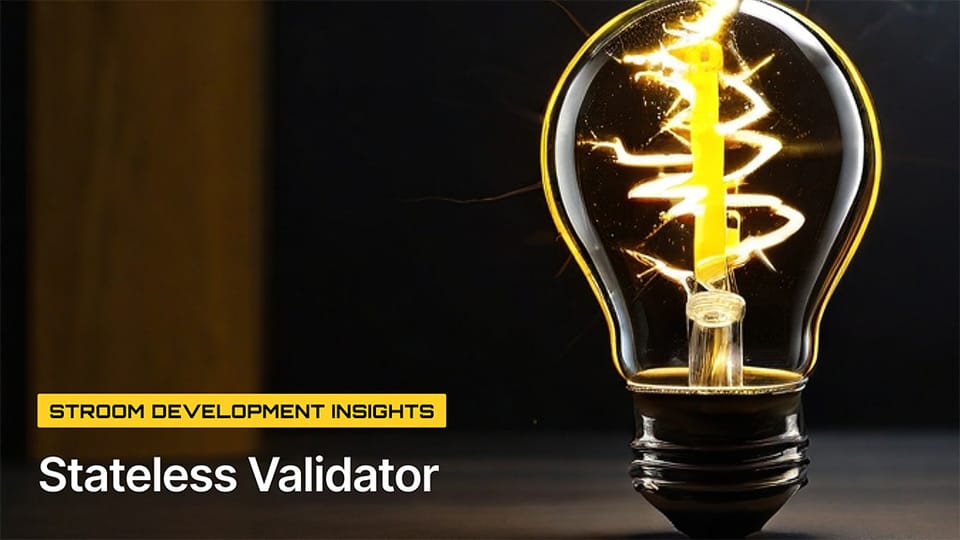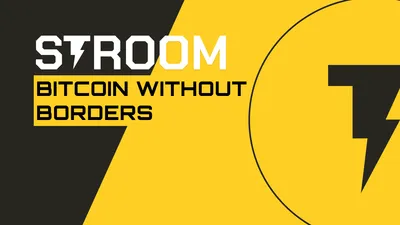Stroom Development Insights: Stateless Validator
We're excited to announce a new initiative: a monthly series of articles focused on the tech side of the Stroom protocol.
•
3 min read

We've been enhancing the Stroom protocol's user experience for some time. However, releasing new features and fixing bugs aren't necessarily the most challenging aspects. Much of the work happens behind the scenes, often going unnoticed.
To address this gap in transparency, we are launching a series of monthly articles authored by our CTO, Slava. This series will offer a detailed glimpse into the most critical work within the Stroom protocol, focusing on the technical side of things. This content requires a solid understanding of the technology behind Bitcoin liquid staking – Stroom’s key offering – to grasp it fully. Despite this, we believe it's essential to maintain transparency with our users as we develop a truly decentralized architecture for Bitcoin liquid staking.
Bridging Bitcoin and Ethereum: A Stateless Taproot-based Validator Approach
If you've been following the Stroom.Network project, you're likely aware of our development of the Bitcoin Liquid Token protocol, which is based on the Lightning Network. However, the necessity of constructing a custom bridge between Bitcoin and Ethereum to achieve our objectives might not be as apparent.
In the world of blockchain, achieving interoperability between different networks has been a persistent goal. While bridges like WBTC exist, linking Ethereum and Bitcoin, they tend to be centralized, relying on single entities. An alternative, the Threshold Network (tBTC), offers a more decentralized approach using a multisig federation for storing Bitcoins. However, its drawback lies in slow transaction speeds, taking hours for the bridging process. Given our plans to utilize the Lightning Network, where transactions must occur within seconds, we recognized the need for a new bridge architecture for Bitcoin and Ethereum.
Introducing the Stateless Taproot-based bridge, a solution designed to seamlessly connect the Bitcoin and Ethereum ecosystems. Similar to the Threshold Network, it relies on a multisig federation of validators responsible for ensuring transaction integrity and security across both chains.
But what sets it apart?
The bridge functions based on the concept that validator software should be stateless, meaning it doesn't require persistent storage. This design ensures that validators can retrieve transaction validation data directly from the Ethereum or Bitcoin blockchains, even if they temporarily go offline or lose connection with other validators. Consequently, there's no necessity for a custom Byzantine Fault Tolerant (BFT)-like consensus mechanism to sync validators, as the Bitcoin and Ethereum blockchains handle this task. This streamlined approach significantly reduces the communication overhead among validators needed to authorize operations within the protocol.
But how does a validator identify which Bitcoin deposit corresponds to which Ethereum user without maintaining its own database? During the bridging process, a user initiates a transfer by depositing assets into a multisig wallet on the Bitcoin blockchain. In our approach, this wallet is cryptographically derived from the validator's joint public key and the user's Ethereum address, thanks to the linear structure of Schnorr signatures. By using the Ethereum address as a tweak, a unique Taproot address is generated, allowing every validator to identify the exact user behind each deposit.
Last but not least, every Schnorr signature created by validators uses FROST. This round-optimized algorithm allows a threshold signature to be created within 1-2 cycles of validator communication, lowering approval time without sacrificing the protocol's security.
What's in it for users?
In a nutshell, security and speed. The most celebrated attribute of the Bitcoin blockchain is arguably its security. Therefore, if we aim to introduce BTC staking to Bitcoin holders, ensuring top-notch security is paramount. Stateless validators eliminate themselves as potential targets for data storage and synchronization attacks.
Speed is one of the core characteristics required for Lightning Network payments. Fast transaction times are essential, allowing connected LN peers to move their Bitcoins effortlessly and reinforce the reliability of Bitcoin payments.
*****
We hope you've found this article helpful. To learn more about Stroom, access detailed information about our technology, or explore how you can join the ecosystem, visit the following resources:
Official website: https://stroom.network/
Whitepaper: https://stroom.network/Primer.pdf
Twitter (X): https://twitter.com/StroomNetwork
Discord: https://discord.gg/DZ53WjDXz9
Telegram: https://t.me/stroomnetwork

Stroom DAO
View our other posts

Bitcoin Without Borders: Unlocking Bitcoin's Multi-Chain Potential
Since the birthday of the first Bitcoin block on January 3, 2009, a new era of financial assets has begun - the cryptocurrency era. Unmatched security, permissionlessness, and decentralization cemented Bitcoin'
Stroom DAO

Lightning Network in 2025: Bitcoin’s Transformation into Everyday Money
Bitcoin’s Lightning Network is transforming from an experiment into a global payment system, making everyday transactions faster and cheaper.
Stroom DAO

Lightning Network: Celebrating 9 Years of Innovation
The Lightning Network whitepaper was unveiled on January 14, 2016, introducing a transformative layer atop Bitcoin for instant, scalable transactions.
Stroom DAO